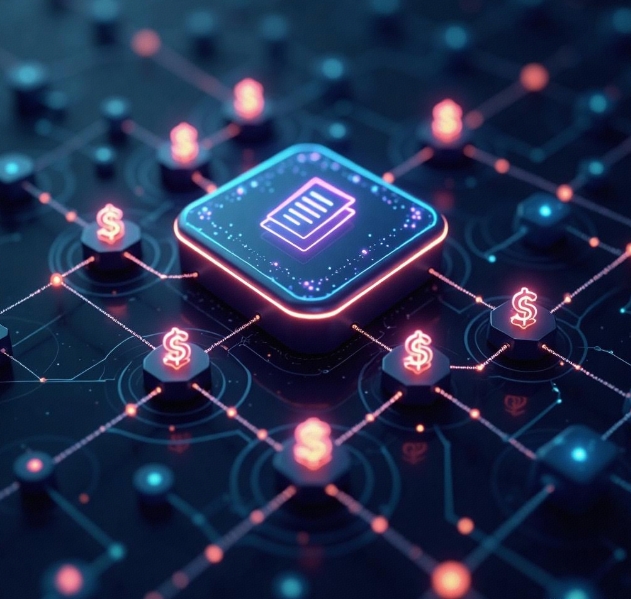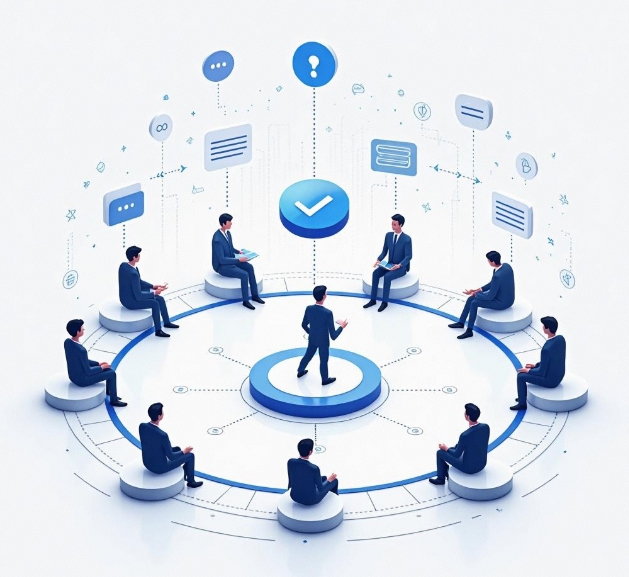DAO development practice: How to build a decentralized autonomous organization in the Web3 ecosystem?
- latest articles
- 1.DApp Development & Customization: Merging Diverse Market Needs with User Experience 2.Analysis of the Core Technical System in DApp Project Development 3.How to achieve cross-chain interoperability in Web3 projects? 4.How does the tokenization of points reconstruct the e-commerce ecosystem? 5.How to Set and Track Data Metrics for a Points Mall? 6.What is DApp Development? Core Concepts and Technical Analysis 7.Inventory of commonly used Web3 development tools and usage tips 8.Development of a Distribution System Integrated with Social E-commerce 9.Six Key Steps for Businesses to Build a Points Mall System 10.What is DApp Development? A Comprehensive Guide from Concept to Implementation
- Popular Articles
- 1.Future Trends and Technology Predictions for APP Development in 2025 2.Analysis of the DeFi Ecosystem: How Developers Can Participate in Decentralized Finance Innovation 3.From Zero to One: How PI Mall Revolutionizes the Traditional E-commerce Model 4.DAPP Development | Best Practices for Professional Customization and Rapid Launch 5.Recommended by the Web3 developer community: the most noteworthy forums and resources 6.From Cloud Computing to Computing Power Leasing: Building a Flexible and Scalable Computing Resource Platform 7.How to Develop a Successful Douyin Mini Program: Technical Architecture and Best Practices 8.Shared Bike System APP: The Convenient Choice in the Era of Smart Travel 9.How to Create a Successful Dating App: From Needs Analysis to User Experience Design 10.From Design to Development: The Complete Process of Bringing an APP Idea to Life
With the development of blockchain technology, Decentralized Autonomous Organizations (DAOs) have gradually become a core component of the Web3 ecosystem. The essence of a DAO is to achieve autonomy on the blockchain through smart contracts, allowing participants to make collective decisions through voting, proposals, and other means, without relying on traditional centralized institutions. This new organizational model not only promotes the practical application of blockchain technology but also brings revolutionary changes to the operational models of enterprises, projects, and communities.
This article will delve into how to develop and build a Decentralized Autonomous Organization within the Web3 ecosystem, analyzing its core technical architecture, development steps, best practices, and challenges.
I. The Concept and Characteristics of DAOs
A Decentralized Autonomous Organization (DAO) is an organizational form that utilizes blockchain technology, smart contracts, and cryptocurrencies for management and operation. Members of a DAO participate in decision-making through token holdings, voting, and other methods, and these decisions are executed via smart contracts, thereby achieving decentralized autonomy.
Several core characteristics of DAOs include:
Decentralized Decision-Making: A DAO has no single controller; decision-making power is collectively held by community members, typically through token ownership or other means of proving participation in governance.
Smart Contract Execution: All operational rules and decision-making processes of a DAO are executed through smart contracts, ensuring transparency, immutability, and reduced human intervention.
Automation and Transparency: The operation of a DAO is automated, with all transactions and decisions recorded on the blockchain, viewable and verifiable by anyone.
Community Governance: DAO governance is typically based on token economics, with members collectively managing and adjusting the DAO's rules through voting, proposals, and other methods.
In the world of Web3, a DAO is not just a governance tool; it is also a way to achieve autonomy for communities, projects, and even enterprises. Whether developers, investors, users, or community members, all can participate in decision-making through the DAO platform.
II. Core Technical Framework for Building a DAO
To build a Decentralized Autonomous Organization, it is essential to master some key components of the Web3 technology stack. These include blockchain platforms, smart contracts, decentralized identity management, token economic models, and more.
Blockchain Platform Selection
A DAO needs to rely on a blockchain platform to realize its decentralized characteristics. Current mainstream blockchain platforms include Ethereum, Polygon, Binance Smart Chain, etc., with Ethereum being the most mature and widely used platform. Choosing the right blockchain platform is crucial, as factors such as performance, transaction fees, and ecosystem of different platforms can impact the DAO's operation.Smart Contract Development
The core of a DAO is the smart contract, which undertakes important functions such as executing governance rules and managing decision-making processes. In smart contracts, operations like how to create proposals, how to vote, and how to allocate resources can be defined.When developing smart contracts, developers typically use the Solidity language (the mainstream smart contract programming language for Ethereum) to write contracts and utilize tools like Truffle and Hardhat for development, deployment, and testing. Once a smart contract's code is deployed on the blockchain, it cannot be modified, which requires developers to be highly cautious in contract design to ensure the security and reliability of the contract.
Decentralized Identity Management
Decentralized Identifiers (DIDs) play an important role in DAOs. They ensure that each member's identity is unique and not controlled by a centralized institution. DIDs can be generated through blockchain technology, ensuring that each participant's actions are traceable and preventing malicious behavior and fraud.Token Economic Model
DAO governance is typically implemented through tokens, which are not only rewards for participants but also tools for governance. Developers can design various token models, common ones including governance tokens (for governance weight) and utility tokens (for payments, incentives). The token economic model needs to consider factors such as token distribution, incentive mechanisms, and voting mechanisms.Decentralized Storage and Data Management
During operation, a DAO generates a large amount of data, which must be stored in a decentralized manner to ensure data security and transparency. Commonly used decentralized storage solutions include IPFS and Arweave. Through these technologies, the DAO's decision-making processes, financial records, voting records, etc., can all be stored in a decentralized manner.
III. Development Steps for a DAO
Building a DAO is not an overnight process; it typically involves multiple development steps, from requirements analysis to code implementation to deployment and maintenance, with each stage being crucial.
Requirements Analysis and Design
Before developing a DAO, it is first necessary to clarify the DAO's goals and functions. For example, is the DAO intended for governing a blockchain project, managing an investment fund, or serving as a decentralized community platform? Different goals determine the DAO's governance structure, token model, and smart contract design.Additionally, the DAO's voting mechanisms, proposal processes, member identity management, etc., need to be designed. The design phase must fully consider the DAO's decentralized characteristics to ensure the governance process is transparent, fair, and effective.
Smart Contract Development
Based on the requirements analysis, developers begin writing smart contracts. Smart contract development needs to consider the following aspects:Proposal Mechanism: How to create proposals, how to submit proposals, and how to design the proposal review process?
Voting Mechanism: How to design voting weight, voting methods, etc.? Is it one person one vote, or voting based on the number of tokens?
Governance Decision-Making: How to ensure the legitimacy of governance decisions? How does the contract automatically execute decision results?
Decentralized Identity and Token Design
Identity management and token economics are the core of achieving decentralized governance in a DAO. Developers need to design an appropriate token model and ensure the identity verification process is decentralized. For example, ENS (Ethereum Name Service) can be used for identity authentication, and token distribution can be carried out through airdrops, mining pools, etc.Testing and Optimization
After completing smart contract development, extensive testing is required. These tests not only verify whether the contract's functions are normal but also ensure the contract's security. Once a smart contract is deployed on the blockchain, it cannot be modified; therefore, the code's rigor must be guaranteed. Common testing methods include unit testing, integration testing, and simulated attack testing.Deployment and Launch
After no issues are found in the testing phase, developers can deploy the smart contract to the mainnet and begin operating the DAO's governance mechanism. During this process, the DAO's contracts should also be audited to ensure there are no potential security vulnerabilities.DAO Operation and Iteration
After the DAO is launched, it is not a one-time effort. The DAO's governance mechanism may change over time, so continuous iteration and optimization are needed. For example, token economics, governance structure, voting mechanisms, etc., can be adjusted based on community feedback.
IV. Best Practices in DAO Development
During the DAO development process, following some best practices can help improve the system's security and operability, reducing potential issues that may arise during development.
Security First
Once a DAO's smart contract is deployed on the blockchain, it cannot be modified; therefore, the security of the smart contract is paramount. During development, use professional security audit tools for code review and ensure the contract code has no vulnerabilities.User Experience Design
The user interface (UI) design of a DAO should be as simple and easy to use as possible, lowering the learning barrier for users. Through clear navigation and straightforward operation processes, users can more easily participate in the DAO's governance.Transparency and Compliance
Transparency is one of the core advantages of a DAO. All governance decisions, financial records, etc., should be publicly transparent, allowing anyone to query and verify them. This can enhance the DAO's credibility and attract more participants.Decentralized Incentive Mechanisms
Designing reasonable incentive mechanisms is key to a DAO's success. Through appropriate token incentives, reward mechanisms, etc., members are encouraged to actively participate in the DAO's governance and development.
V. Challenges Faced by DAOs
Although DAOs, as a form of decentralized governance, have broad prospects, they still face some challenges in actual development and operation:
Governance Efficiency and Participation
Although DAO governance mechanisms can achieve decentralization, how to improve governance efficiency and community participation remains a challenge. Many DAOs have low voting participation rates, and the decision-making process can be slow.Smart Contract Security
DAOs rely on smart contracts to execute decisions, and once deployed, smart contracts cannot be changed; therefore, contract security is a major challenge for DAOs. Even after audits, vulnerabilities may exist, leading to fund losses or governance failure.Legal and Compliance Issues
As a decentralized organization, DAOs lack clear regulations within legal frameworks. How to operate compliantly in different countries and regions, and how to resolve issues of DAO members' responsibilities and obligations, remain pressing challenges to be solved.
VI. Conclusion
As an important component of the Web3 ecosystem, DAOs have immense development potential. Through decentralized governance mechanisms, DAOs can achieve decentralized autonomy, providing a fairer and more transparent decision-making platform. However, to build a successful DAO, developers need a deep understanding of core technologies such as blockchain, smart contracts, and token economics, and must continuously optimize and iterate during actual development. Although facing some challenges, with the continuous advancement of technology and the maturation of communities, DAOs will play an increasingly important role in the future digital economy.
-

How to achieve cross-chain interoperability in Web3 projects?
With the continuous development of WEB3 technology, Web3 has gradually become an···
-

Inventory of commonly used Web3 development tools and usage tips
With the continuous development of blockchain technology, Web3 has become a hot ···
-

Web3 development trend prediction: analysis of future technology directions and application scenarios
With the gradual development of blockchain technology, the concept of Web3 has m···

 Blockchain
Blockchain












